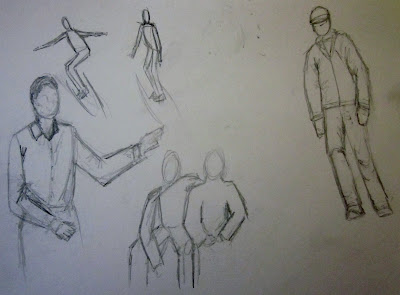RESEARCH POINT- Investigate some
artists self-portraits. Look at both well-known
and lesser known artists.
I started off by looking at one of the
self-portraits of Vincent van Gogh.
This was an oil painting entitled ‘Self-portrait
with a felt hat’. Painted in 1888, in the impressionistic style, this portrait
may have been painted for many reasons: To mark a moment in time, to try out
various painting techniques and to improve his skills as an artist. Also it
might have been easier to paint oneself rather than to pay a model for their
time, if funds were short. The pose is
one of thoughtfulness and concentration with his gaze slightly over to one side,
and muted colours are used throughout.
---------------------------------------------------------------------------------------------------------
The next artist I chose to look at is;
Lucian Freud (1922 – 2011). He was one of the
most important and influential artists of his generation, and the paintings he
made of people were central to his work.
He was quoted to have said, 'I've
always wanted to create drama in my pictures, which is why I paint people. It's
people who have brought drama to pictures from the beginning. The simplest
human gestures tell stories.'
You can clearly see the drama in every
brushstroke of his self-portrait. Every
plane of his face is filled with expressive colours and contours, bringing the
portrait to life. He is thought to have
worked for many hours on each painting, building up thick layers of paint to
create a three dimensional effect to his work.
---------------------------------------------------------------------------------------------------------
This next drawing is a self-portrait drawn by
artist Paul Rodecker. It was posted on his drawing blog in 2009. He used a number of thin black sharpies and
the effect is seriously intense, with the gaze almost daring you to blink.
---------------------------------------------------------------------------------------------------------
This next
painting was entitled ‘Self-portrait with easel’ by Gustave Caillebotte (August 19, 1848-February 21, 1894). He was a
French painter and a member of the group of artists known as Impressionists. What is interesting about his self-portrait is
the way the artist is obviously looking in a mirror to paint the picture. Apparently he was not left handed, yet in the
painting he is clearly seen holding the brush in his left hand.
---------------------------------------------------------------------------------------------------------
The last artist I
will look at is Norman Rockwell. He was
born in 1894 and produced over 4,000 original works in his lifetime. Alongside his paintings he was also an
illustrator, and was commissioned to illustrate over 40 books.
The painting
entitled ‘Triple self-portrait’ was a chance for Rockwell to reveal something
of his character and profession. This he
does by the pose of viewing himself in a mirror, surrounded by items of his trade;
easel, pallet, canvas, brushes and a full waste bin. The image on the canvas is incomplete, in
black and white, and clearly not giving too much clarity to the artists’ image
of himself. The image in the mirror is even
more intriguing. This time in full colour surrounded by a flashy gilt frame
complete with American eagle. But, the eyes of the artist are hidden.
Suggesting the artist is seeing a distorted image of himself, or hiding his
inner soul from the viewer. The artist’s has signed the corner of the incomplete
portrait rather that at the lower corner of the main painting.














































